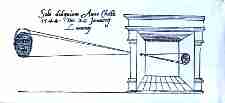Toronto. At left is a c1544 drawing of a camera obscura showing a solar eclipse. In the image, the left wall has a pin-hole to let in the light. The right wall acts as a screen to allow the image of the sun to be projected and viewed. The construction between the two is a light tight box (one wall is removed in the drawing to show how it works). The image shown is courtesy of the Gernsheims’ book “The History of Photography“, long out of print (mine is the 1969 Thames and Hudson edition).
The most basic description of a camera is essentially the same: a light-tight box with the sensitive media at one end (instead of the wall) and a lens (instead of a pin-hole) and shutter mechanism at the other with the distance between them suitable to sharply focus a subject (about 10 feet away from the box) on the sensitive media.
In the days when media were crushingly slow, a hat, hand, lens cap, etc over the lens served as a shutter. Exposing the lens for a few seconds (or longer) allowed enough light to hit the sensitive media to record a latent image suitable for development.
Improvements at the media end of the light-tight box permitted rapid exchange of plates and later film without further unintended exposure to light.
Improvements at the lens end of the box were often more complex including a means to focus on a subject closer than 10 feet, a reduced ‘aperture’ to increase the amount of the foreground and background in focus (faster lenses used Waterhouse stops or variable aperture leaves to reduce or ‘stop down’ a lens and improve the depth of focus). Different combinations of elements were used to flatten the image projected on the media and correct various imperfections. Some worked; some didn’t.
While today many cameras use variable focal length (zoom) lenses to vary focal length (and angle of view) others use interchangeable prime lenses or at least their front elements. Many zooms are also interchangeable to expand the focal length covered, or allow the use of prime lenses with special attributes.
Traditionally, lens elements were spherical (convex or concave) or plane and made of glasses with differing densities. Post WW2 special element coatings became common reducing inter-element reflections and improving contrast. A few decades later we began to see aspheric elements too. The goal was always to improve resolution, expand coverage, flatten the plane of focus and reduce or eliminate distortion – geometric, astigmatic, colour etc.
Digital technology brought with it a whole new science of photography. Quickly sensors had ISO ratings that began where the fastest film left off. Sophisticated computer chips reduced noise, sharpen images, changed saturation, auto focussed the camera, etc. Once shot, results could be displayed almost instantly. Thousands of shots could be taken on a sensor. No need to buy more film!
And lenses changed too. The smaller the size of the media (sensor), the shorter the focal length of the lens for the same angle of view. With smart phones, the sensor is so tiny a focal length of 2 or 3 mm has the same angle of view as a 35mm camera with a 35mm lens. With the strides in technology, some modern digital cameras can be bought with sensors of over 60mp allowing the use of electronic ‘zoom’ to create an image as if a zoom or longer focal length lens was used – just crop the 60mp size down!
So what is a camera … really! Visit our 2025 events to add to your collection – Next in line is our fall fair on October 19th. Details are in issue 25-7 of our PHSC News.









